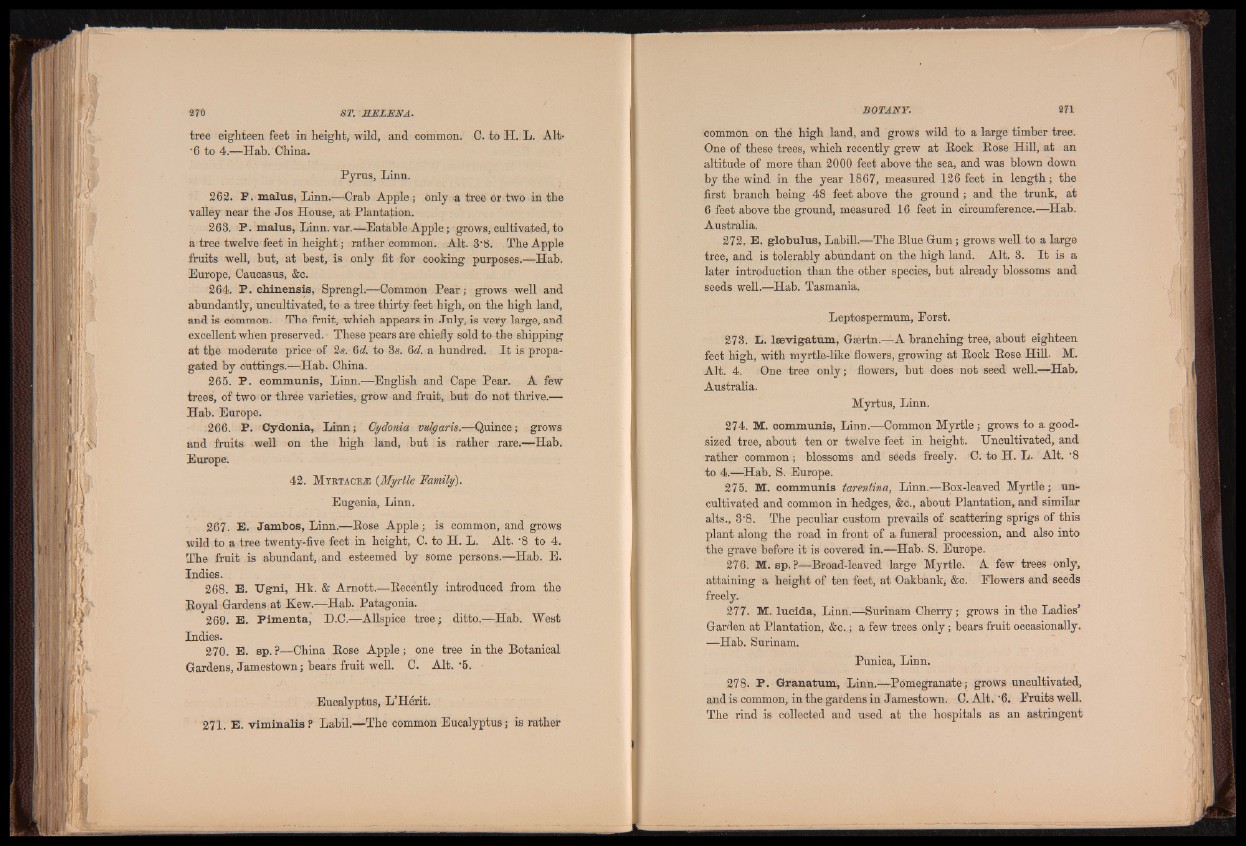
tree eighteen feet in height, wild, and common. C. to H. L. Alt-
'6 to 4.—Hah. China.
Pyrus, Linn.
262. P. malus, Linn.—Crab Apple; only a tree or two in the
valley near the Jos House, at Plantation.
263. P. malus, Linn. var.—Eatable Apple; grows, cultivated, to
a tree twelve feet in height; rather common. Alt. 3'8. The Apple
fruits well, but, at best, is only fit for cooking purposes.—Hab.
Europe, Caucasus, &e.
264. P. chinensis, Sprengl.—Common P e a r; grows well and
abundantly, uncultivated, to a tree thirty feet high, on the high land,
and is eommon. The fruit, which appears in July, is very large, and
excellent when preserved.- These pears are chiefly sold to the shipping
at the moderate price of 2s. 6d. to 3s. 6d. a hundred. I t is propagated
by cuttings.—Hab. China.
265. P. communis, Linn.—English and Cape Pear. A few
trees, of two or three varieties, grow and fruit, but do not thrive.—
Hab. Europe.
266. P. Cydonia, Linn; Cydonia vulgaris.—Quince; grows
and fruits well on the high land, but is rather rare.—Hab.
Europe.
4 2 . M yktace.® (Myrtle Family).
Eugenia, Linn.
267. E. Jambos, Linn.—Rose Apple; is common, and grows
wild to a tree twenty-five feet in height, C. to H. L. Alt. -8 to 4.
The fruit is abundant, and esteemed by some persons.—Hab. E.
Indies.
268. E. Ugni, Hk. & Arnott.—Recently introduced from the
Royal Gardens at Kew,—Hab. Patagonia.
269. E. Pimenta, D.C.—Allspice tre e ; ditto.—Hab. West
Indies.
270. E. sp. ?—China Rose Apple; one tree in the Botanical
G a r d e n s , Jamestown; bears fruit well. C. A l t . -5. ■
Eucalyptus, L’Herit.
271. E. viminalis? Labil.—The common Eucalyptus; is rather
common on the high land, and grows wild to a large timber tree.
One of these trees, which recently grew at Rock Rose Hill, at an
altitude of more than 2000 feet above the sea, and was blown down
by the wind in the year 1867, measured 126 feet in length; the
first branch being 48 feet above the ground; and the trunk, at
6 feet above the ground, measured 16 feet in circumference.—Hab.
Australia.
272. E. globulus, Labill.—The Blue Gum; grows well to a large
tree, and is tolerably abundant on the high land. Alt. 3. I t is a
later introduction than the other species, but already blossoms and
seeds well.—Hab. Tasmania,
Leptospermum, Porst.
273. L. lsevigatum, G s e r tn iA branching tree, about eighteen
feet high, with myrtle-like flowers, growing at Rock Rose Hill. M.
Alt. 4. One tree only; flowers, but does not seed well.—Hab.
Australia.
Myrtus, Linn.
274. M. communis, Linn.—Common Myrtle; grows to a good-
sized tree, about ten or twelve feet in height. Uncultivated, and
rather common; blossoms and seeds freely. C. to H. L. Alt. '8
to 4.—Hab. S. Europe.
275. M. communis tarentina, Linn.—Box-leaved Myrtle; uncultivated
and common in hedges, &c., about Plantation, and similar
alts., 3'8. The peculiar custom prevails of scattering sprigs of this
plant along the road in front of a funeral procession, and also into
the grave before it is covered in.—Hab. S. Europe.
276. M. sp. ?-—Broad-leaved large Myrtle. A few trees only,
attaining a height of ten feet, at Oakbank, &c. Flowers and seeds
freely.
277. M. lucida, Linn.—^Surinam Cherry; grows in the Ladies’
Garden at Plantation, &c.,; a few trees only; bears fruit occasionally.
—Hab. Surinam.
Punica, Linn.
278. P. Granatum, Linn.—Pomegranate; grows uncultivated,
and is common, in the gardens in Jamestown. C. A lt. '6. Fruits well.
The rind is collected and used at the hospitals as an astringent